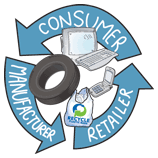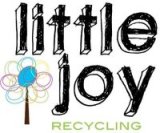
Graphic: GrassRoots Recycling Network
Many believe that trash is an inevitable byproduct of modernity, as if humankind is forever doomed to bury or burn our waste because, with apologies to 90s pop sensation The Rembrandts, “That’s just the way it is, baby.” Fortunately, the way it is doesn’t necessarily equal the way it must be. In fact, you can participate in a number of exciting initiatives that currently work to bring us to Zero Waste…or darn close.
As a concept, Zero Waste embraces a “cradle-to-cradle” system, in which the products we make, sell and purchase are used to make new products rather than dumped in a landfill or burned in an incinerator. Pragmatically, Zero Waste is a set of concrete practices that mirrors nature in an effort to conserve resources, reduce trash, increase reuse and recycling, promote durability and preserve wealth. Sounds ambitious, right? Well, yes and no, especially in light of the ramifications associated with maintaining the status quo.
First, consider our current waste(ful) scheme: we extract natural resources from the earth, manufacture those resources into consumer products, ship those products all over the world in planes and boats and trucks, then buy and use them until they become obsolete and finally toss them in the garbage. This is a linear, “cradle-to-grave” approach: extract-manufacture-distribute-consume-dispose…repeat. Our present waste management regime promotes the continuous extraction of limited resources to perpetuate an unsustainable cycle. For a terrific, illustrative video on unsustainable production, see the Story of Stuff.
Second, consider the economic value of the resources that we constantly bury in the ground after short-term use: the precious metals in our trashed electronics, the easily remanufactured textiles in our clothes and furniture, the wood in our millions of tons of discarded paper—all of these have value as potential raw materials—simply disappearing into a monetary sinkhole. Garbage dump becomes money pit. Every ton of reusable materials that end up in a landfill leads to ever-more costly (both economically and environmentally) mining, logging and drilling.
Now consider a sustainable alternative, one in which products and the value (again, economically and environmentally) residing in the resources consumed to create them are not buried or burned, but instead become an entirely new, higher quality product. This is the core of Zero Waste: every material used in the production cycle functions as feedstock, a “nutrient” used to make new products. In their seminal work, Cradle to Cradle, William McDonough and Michael Braungart describe “technical nutrients” that can be utilized over and over in manufacturing processes without suffering any deterioration in quality and “biological nutrients,” organic matter which breaks down in the environment to feed living organisms and perpetuate life. Nature functions this way: the byproducts of an oak tree or a tree frog re-enter the environment to help new trees or frogs or something entirely different grow until their byproducts re-enter the system. A cycle of living, a closed loop. Zero Waste takes this bio- and ecological reality and applies it to contemporary culture.
Several fundamental principles guide Zero Waste practices; in turn, the integration of several such practices constitute a Zero Waste Plan. Companies or government entities that implement a Zero Waste Plan commit to: 1) “cradle-to-cradle” design and materials use; 2) “producer takeback” policies, in which manufacturers assume responsibility for the end-of-life care of their products; and 3) “triple bottom-line” accounting, which considers not only the economic impacts of an action but also the environmental and ethical costs of a particular manufacturing process or product design.
Right now, many individuals, cities, companies and governments are beginning to formulate and implement comprehensive Zero Waste Plans into their local and regional solid waste management systems. In fact, the entire nation of New Zealand implemented precisely this type of plan in July of this year. Diverse companies ranging from Fetzer Wine to Subaru to Xerox already divert more than 90% of their waste.
On a local level, several communities already ramped up efforts reduce waste. Austin became the first city in Texas to adopt a formal Zero Waste Plan. Dallas has expanded its single-stream recycling program citywide, resulting in huge gains in recovered material. Houston has launched an yard/tree waste mulching program that is expected to save he city $2 million each year. On the corporate front, one Toyota and GM joint manufacturing plant convinced its parts suppliers to switch from cardboard to reusable shipping containers—this step alone saves the companies an estimated $20 million a year.
At home, you can do your part to move toward Zero (or darn close). Consume less wasteful packaging by purchasing products that contain post-consumer recycled content. Compost your food and yard waste in the back yard. When remodeling, use sustainably harvested materials such as bamboo flooring and recycled glass counter-tops or tile. If you’re in the market for a new home, you can get to Zero Waste by installing several amenities such as solar or tankless water heaters, rainwater-fed washing machines, LED lighting and metal roofing. In Dallas, one eco-friendly couple is blogging their trials and tribulations with green design as they build a new home—the Labron House—from the ground up. Check out their progress at http://blog.greenlabron.com.
Jeffrey Jacoby, Staff Director, Texas Campaign for the Environment
Article originally published in September 2009 issue of House & Home Magazine
Filed under: Recycling, Sustainable production & consumption, Zero Waste | 2 Comments »
 This recent article in the Technology and Science blog, “A Long Term Recycling Plan For Your Products“, highlights the limitations of traditional recycling and the long-term solutions Producer TakeBack programs can offer. From the post:
This recent article in the Technology and Science blog, “A Long Term Recycling Plan For Your Products“, highlights the limitations of traditional recycling and the long-term solutions Producer TakeBack programs can offer. From the post:





 Here’s a great TV story from KVUE News Austin:
Here’s a great TV story from KVUE News Austin:

















